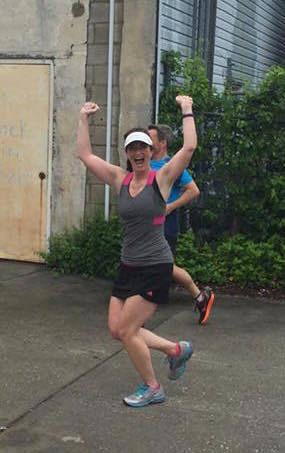At the risk of sounding weirder than usual, I need to confess that sometimes I stare at other women’s breasts. Ok, let me explain. After standing on the sidelines last fall for my town’s first marathon, I was dumbstruck. Not by the sweat dripping down people’s faces or the look of determination in their eyes, but by the amount of women running by with horrible bras on. There were so many times I wanted to run out, shake a random women and say, “Do you have any idea what you are doing to those breasts of yours?”

I’ve rounded up some easy tips on what to look for in a sports bra, when to replace them, and how to maintain them.
Why Wear One?
The main ligament that helps keep the perky look to breasts is the Cooper’s ligament. As that ligament sags (from age and constant bobbing up and down) the breasts become flattened. There is a real injury called Joggers Breast. The continuous movement of the up and down and side to side can injure the breasts, and for bigger-breasted women it can also affect the shoulder and neck muscles.
I like to say, “Prevention is simple…droop is forever!”

Two Types of Sport Bras:
Compression does just that, compresses the breasts by pushing the breasts against the chest wall. These bras usually go over the head and are best for A cup size. The side effect of a larger-busted woman wearing a compression bra is the “uni-boob” look and it can be difficult to get in and out of (especially after a long run and when you are super sweaty!). I actually dislocated my shoulder trying to get out of my bra and know of women who have had to cut themselves out of compression bras.
Encapsulation puts the breasts into separate cups, similar to a regular bra, but with much better support in the straps and band. This type of bra usually has a clasp in the back and is better suited for women with breasts larger than a B cup size.
How to pick one:
The first thing to remember is your sports bra size is not the same as your everyday bra size! For example, I am a C cup in my day-to-day bra, but a D size in my sports bras.
- Make sure the band fits over your breast- can you take a deep breath?.
- The whole breast should fit inside the bra- cleavage is great for a fancy night on the town, but not for a workout
- The straps should be comfortable- they should not be falling off or digging into your shoulders
- Try it on like you would your running shoes- run around in it and jump up and down
- Your breasts should feel secure- not bouncing up and down or side to side
Keep it clean:
The rules are simple, wash your bra every 1 to 3 wears. If you are unsure whether to wash it or not, rule of thumb is to wash it. You will feel better in a clean fresh smelling bra and your workout buddies will appreciate it too!
- Wash it in warm water, not hot water
- Use non-chlorine detergent
- NEVER put it in the dryer
- Stay away from lotions and sunscreens- they can affect the material
- Rotate usage
- Use The Rule of Three: One to wear, One in wash, One hanging to dry
Time to replace:
I am in the habit of replacing my bras when I buy new sneakers. I’m already in the store buying my sneakers, why not spend the extra money to protect my breasts.

Here are some signs that it’s time to ditch the ones you have:
- The straps are stretched out
- You can’t read the tag
- The cups are stretched out
- The band has lost it’s elasticity
- You have lost more than 10 pounds
- You notice extra movement or your neck and shoulders are bothering you
We know the importance of investing in a good pair of running sneakers- now let’s get in the habit of investing in a great running bra.
Let’s get more ladies talking about how we can keep our breasts healthy and happy! These are my tips, what are yours? Share them on my Facebook!




great informative post!
Glad you liked it Emily!
Hi, I believe your blog might be having internet browser compatibility problems.
Whenever I look at your blog in Safari, it looks fine however, if opening
in Internet Explorer, it’s got some overlapping issues.
I simply wanted to provide you with a quick heads up!
Apart from that, fantastic blog!
Thanks for letting me know Christine 🙂
And glad you liked the blog!
It’s perfect time to make some plans for the future and it’s time
to be happy. I’ve read this post and if I could I desire to suggest you some interesting
things or advice. Perhaps you could write next articles
referring to this article. I want to read even more things about it!
Great info, and thank you and I love your writing!
Glad you enjoyed the blog post Sandy 🙂
Cheers to your health!
Maintain the good job and delivering in the group!
madden 17 coins http://www.public-sharing.com/blogs/post/7393
Fantastic web site you have got right here
nba 2k17 vc http://swdb.it/index.php?topic=7868.0
I have read so many articles or reviews about the blogger lovers
except this post is in fact a nice post, keep
it up.
Terrific Website, Keep up the very good work. Thank you so much!.
I just want to tell you that I am just all new to blogs and actually enjoyed this web blog. Most likely I’m planning to bookmark your site . You really come with remarkable article content. Many thanks for sharing with us your website.
Thank you so much! I’m so glad you enjoyed the post.
~Christine
Wonderful blog! I stumbled upon it while browsing
on Yahoo News. Have you got any tips concerning how to get placed in Yahoo News?
I’ve been trying for a time nevertheless i never seem to arrive there!
Cheers
Thanks:) glad you enjoyed the blog post. As for Yahoo News…keeping pitching ideas!
I’m just writing to make you be aware of what a exceptional experience my friend’s girl enjoyed browsing your blog. She discovered a lot of things, with the inclusion of what it’s like to possess an amazing helping spirit to get most people without hassle learn about several complicated issues. You undoubtedly did more than our expectations. Thank you for producing such important, healthy, edifying not to mention unique tips on your topic to Julie.
Glad my message of health and wellness was well received 🙂